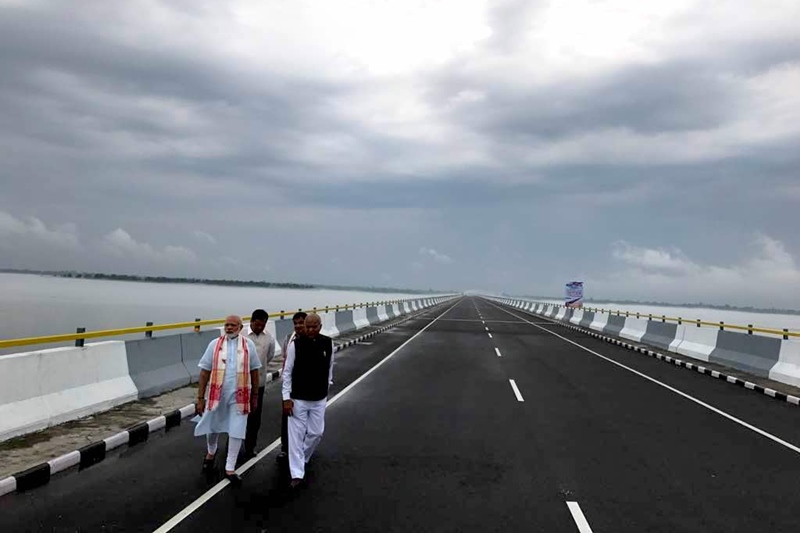
Prime Minister, Narendra Modi walking over Dhola-Sadia.
India’s longest river bridge has been inaugurated yesterday, 26 May 2017 by our honorable Prime Minister, Narendra Modi. The Bhupen Hazarika Setu or the Dhola- Sadiya Bridge is not only a connectivity for the inhabitants of North-east India but it is a way of maintaining a cordial relation between the two contiguous states of North-eastern part of India. The link communicates the message of peace, harmony, and brotherhood. Apart from the above said primary reason, let’s look at some other key features of this bridge:
- Longest Bridge in India: The Dhola- Sadiya Bridge is 9.15 km long which is 3.55km longer than the Bandra-Worli Sea Link in Mumbai making it the longest bridge in India.
- Reducing the travel time: The passengers or travelers need not wait for a ferry to get them the other side of the river Brahmaputra. As the flyover lengthens Dhola in South to Sadiya in North connecting the states of Assam and Arunachal Pradesh. One can traverse the distance from the current six hours to one hour from Rupai on NH-37 in Assam to Meka/Roing on NH-52 in Arunachal Pradesh.
 Dhola Sadiya Bridge
Dhola Sadiya Bridge
- No fear from floods and earthquake: As Assam has always been under the threat of natural calamities like flood and earthquake restricting the people of either side of the Brahmaputra River to commute. The Dhola-Sadia Bridge having seismic buffers in all its 182 piers has come to the rescue ensuring 24*7 connectivity between upper Assam and eastern parts of Arunachal Pradesh.
- Little savings won’t harm: The connectivity will help saving Petrol and Diesel worth Rs.10 lakh per day.
- Benefits to our land protectors: It also provides help to the Indian army and Indian Defence forces in the region. It helps in the military commute from one region to the other saving time to travel from Assam to the posts along the India-China border in Arunachal Pradesh.
- Socio-economic development and life to the poor: The overpass also ensures to provide better and efficient road connectivity to the backward regions of Assam and parts of Arunachal Pradesh. Moreover, increase in numerous hydro power projects increases the chances of employment opportunities.





 Prime Minister, Narendra Modi walking over Dhola-Sadia.
India’s longest river bridge has been inaugurated yesterday, 26 May 2017 by our honorable Prime Minister, Narendra Modi. The Bhupen Hazarika Setu or the Dhola- Sadiya Bridge is not only a connectivity for the inhabitants of North-east India but it is a way of maintaining a cordial relation between the two contiguous states of North-eastern part of India. The link communicates the message of peace, harmony, and brotherhood. Apart from the above said primary reason, let’s look at some other key features of this bridge:
Prime Minister, Narendra Modi walking over Dhola-Sadia.
India’s longest river bridge has been inaugurated yesterday, 26 May 2017 by our honorable Prime Minister, Narendra Modi. The Bhupen Hazarika Setu or the Dhola- Sadiya Bridge is not only a connectivity for the inhabitants of North-east India but it is a way of maintaining a cordial relation between the two contiguous states of North-eastern part of India. The link communicates the message of peace, harmony, and brotherhood. Apart from the above said primary reason, let’s look at some other key features of this bridge:
 Dhola Sadiya Bridge
Dhola Sadiya Bridge